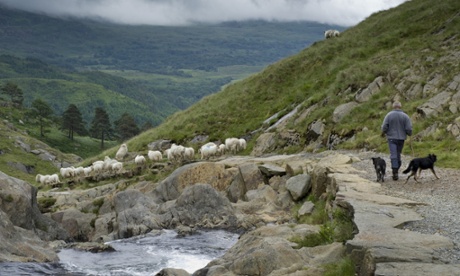The views from the top – as long as the mist and cloud stay away – are spectacular and the sense of achievement, after the lung-bursting climb, overwhelming.
But conservationists and mountain rescuers are urging hikers to show more “respect” to one of the UK’s most beloved mountains amid growing concern that a sharp increase in the number of walkers is causing lasting damage and too many people are trying to climb the peak without preparing properly.
The Snowdonia Society said Snowdon – Yr Wyddfa in Welsh – was being blighted by footpath erosion, littering and careless wild camping while Llanberis mountain rescue team (MRT)warned that it was seeing a worrying rise in the number of people trying to climb the 1,085-metre (3,560ft) peak in north Wales without the proper equipment or planning.
John Harold, the director of the Snowdonia Society, said he believed that many people came to Snowdon having been charmed by idyllic social media images of the mountain, the largest in Wales and England, but had little grasp of how to look after it or stay safe.
He said: “In order to respect something you need to have some knowledge or relationship with it. I think what we’re seeing is a high proportion of people coming who have seen attractive images on social media or elsewhere and thought, cool, I’ll have some of that.”
The number of people climbing Snowdon this summer is believed to have increased because so many more UK residents have opted to holiday in Britain and there have sometimes been 45-minute queues to cover the last few metres to the summit.
Harold said: “The simple fact is that Snowdon is a really big mountain. It is not a walk in the park, a trip down the high street or a day at a festival. People need to be better prepared and have realistic expectations about what they are going to experience.”
The Snowdonia national park authority has introduced measures to try to manage the increase in visitor numbers, including a booking system for a key car park and introducing shuttle buses. It has made the point that the national park covers 800 sq miles (208,000 hectares) and suggested people visited the beaches, the castles and the Celtic rainforest as well as making a beeline for Snowdon.
Harold said a particular social media image he believed was attracting people to the mountain was “that idyllic picture of a lonely tent on a mountain ridge with not a soul in sight”. He added: “There are people who know how to wild camp. Nobody sees them. They pitch after dark and take their tent down before the sun comes up and don’t leave a trace.
“Those sort of people are as appalled as we are by what’s being done in the name of wild camping. I’ve seen scorch marks from barbecues all over the place, broken tents scattered around.”
Harold said if people prepared properly, the mountain and organisations involved in managing it would benefit. “But it’s also much better for visitors,” he said. “It’s not fun going up a 3,500ft mountain in footwear that hurts, no fun if you haven’t got food and drink, no fun at all if you get lost.”
So far in August, the Llanberis MRT has been called out 38 times, compared with 25 last year and 21 in 2019. It has had to deal with a string of people becoming “cragfast” – stuck on a steep section unable to either ascend or descend – but it also had to help walkers suffering heat stroke and asthma, rescued hikers who fell or were hit by falling rocks and searched for lost tourists.
One of the team’s coordinators, Gruff Owen, called for people to do more research from trustworthy sources such as Adventure Smart. “There are amazing resources. Unfortunately, people seem to rely on what they see on social media rather than carrying out authoritative research.”
Owen said he and his colleagues opposed ideas such as charging for access to the mountain, making people book slots to climb it or forcing people to have insurance before walking it. “All of that sort of thing sullies the spirit of right of access. We just have to find ways of getting the messages over.”











